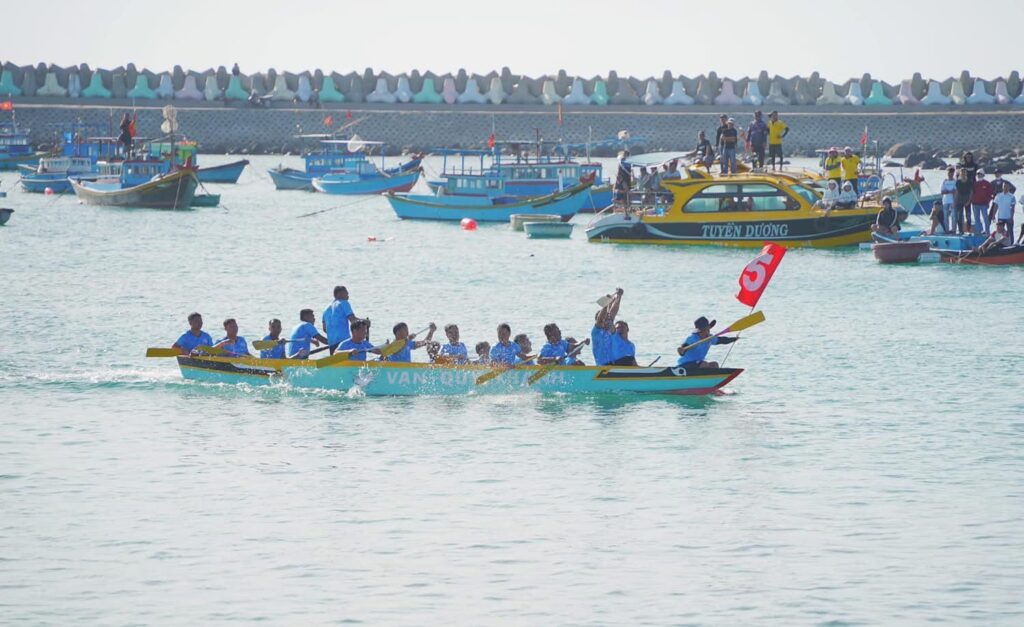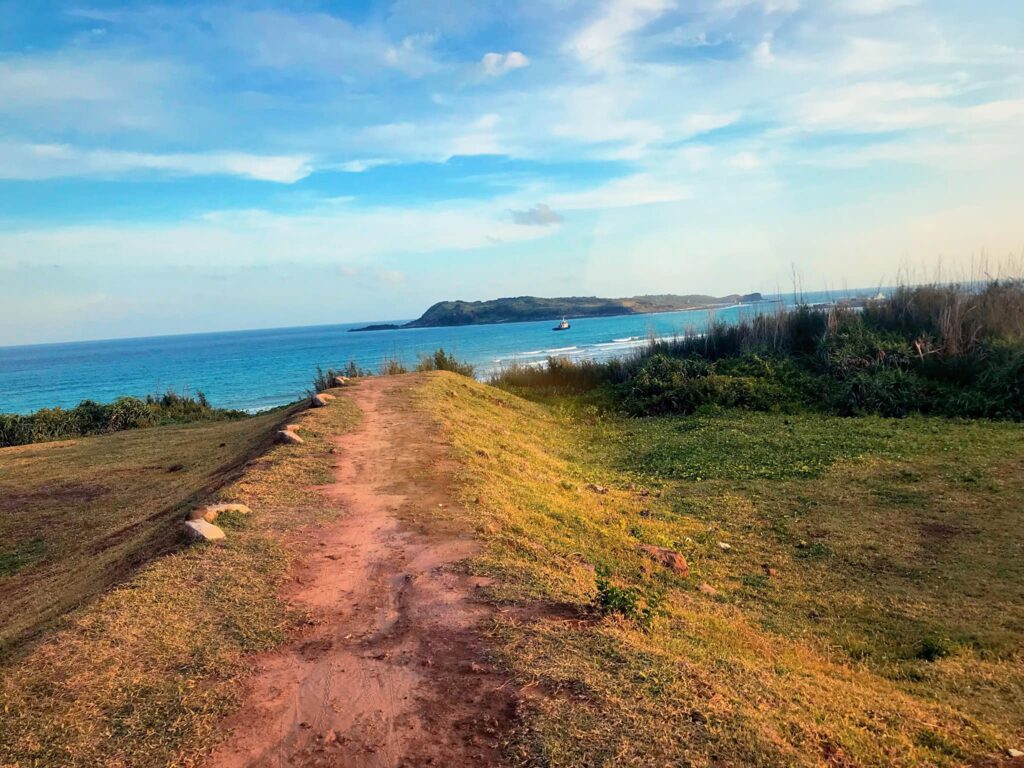Lam Dong Province currently has 124 commune-level administrative units, consisting of 103 communes, 20 wards, and one special zone. The only one of its kind is the Phu Quy Special Zone — a small, remote island surrounded by vast ocean. Here, endless rolling waves blend with iconic natural scenery, rows of swaying coconut palms, and long stretches of white sand, all forming a spectacular yet poetic portrait of this beloved corner of Vietnam.
Located 56.7 nautical miles (about 105 km) from Phan Thiet City to the East–Southeast, Phu Quy Island appears in the middle of the East Sea with a remarkably unique shape. From the eastern viewpoint, many believe the island resembles a majestic dragon rising from the sea (with the “dragon head” at Long Hai, the “body” at Tam Thanh, and the “tail” at Ngu Phung). From the north, it looks like a mackerel; from the southwest, like a giant whale emerging from the water, with its head at Mount Cao Cat and its tail at Ong Dun Hill. Standing at Doi Thay (Long Hai) and looking toward Cao Cat Mountain, the shape even resembles a dragon holding a pearl.
Phu Quy is an archipelago, surrounded by 10 islets located one to 100 km from the main island, locally called “small islands” (hòn lẻ). Each islet has a distinct name based on shape, color, or the story behind it, such as Hon Trung Lon, Hon Den, Hon Do, Hon Giua, Hon Hai, Hon Do Lon, Hon Ty, and Hon Do Nho. There is also Hon Tro, a small islet formed in 1923. The largest of all is Hon Tranh, shaped like a miniature “S-shaped map of Vietnam,” only 0.5 nautical miles from the main island. Sheltered by surrounding mountains, Hon Tranh enjoys calm seas year-round and is tied to numerous legends and spiritual beliefs among local fishermen.
The main island of Phu Quy — home to the vast majority of residents — is slightly rectangular in shape, covering a modest area of roughly 16.4 km², consisting of hills, mountains, and flatlands. With harsh climate conditions shaped by the monsoon system — the southern winds from May to August and the northern winds from September to April — combined with strong winds, high temperatures, poor soil, limited freshwater, and primitive farming techniques, life on the island has always been challenging. These natural conditions have significantly influenced both the material and spiritual life of the island’s inhabitants, giving rise to a rich and distinctive body of island folklore that reflects their struggles, creativity, and emotional world.
The formation and development of Phu Quy Island have undergone several administrative changes. The island’s origins in Vietnamese history date back to the Pre-Le period (981–1009). Ancient chronicles such as Dai Nam Nhat Thong Chi describe it as follows:
“Thuan Tinh Island: a lone island rising in the East Sea, directly aligned with the coast of Phan Ly. The island is 15 miles long, surrounded by sandy shores, inhabited by 11 villages under the governance of local leaders, annually contributing cloth tax to the imperial court.”
Archaeological evidence from the island’s Early and Prehistoric periods reveals continuous human settlement since ancient times. Numerous relics — unearthed across all three communes — include fragments of pottery from ancient burial sites, stone axes, and tools used by early inhabitants. Other artifacts relate to traditional occupations such as weaving, peanut processing, and lime-jars used for betel chewing. During stone quarrying, large burial jars were discovered, containing stone tools such as hammers and intricately crafted stone bracelets.
Based on extensive archaeological surveys over the past 20 years conducted by the Binh Thuan Museum and the Vietnam Institute of Archaeology, artifacts such as axes, adzes, and burial jars confirm that Phu Quy’s prehistoric sites belong to the late Sa Huynh culture transitioning into early Cham culture, dating back 2,500–3,000 years. Two leading archaeologists, Professor Trần Quốc Vượng and Professor Hà Văn Tấn, concluded that “the Sa Huynh people were the direct ancestors of the Cham who later established the Champa Kingdom.”
Thus, from early times, the Cham developed a rich, vibrant culture and a prosperous socioeconomic life in this region. Oral traditions also suggest that before mainland settlers arrived, indigenous groups lived off foraging and near-shore fishing. Yet how that ancient culture developed, how its people lived and worked — these remain open questions that continue to intrigue historians.
Throughout history, the island has had many names: Koh-rong (Cham language), later Co Long, Thuan Tinh, Cu Lao Khoai Xu, Cu Lao Thu, Dao Chin Lang, and Phu Quy (Poulo Cecir de Mer).
The name Cu Lao Khoai Xu comes from a legend in which northern fishermen, during a flying-fish harvesting trip, landed on the island. As they left, they buried some sweet potatoes in the soil. When they returned and saw the roots sprouting into lush plants bearing large tubers, they named the island “Khoai Xu.”
The name Dao Chin Lang (“Island of Nine Villages”) originates from nine groups of central Vietnamese fishermen who settled here, naming their new villages after their hometowns — such as My Khe, An Hoa, My Xuyen, and Phu Ninh — to honor their roots.
The name Cu Lao Thu comes either from the island’s mackerel-like shape or from the fact that it was once a major fishing ground for mackerel (cá thu).
During the early Nguyen Dynasty, the island was called Tong Ha, under Tuy Phong District, Binh Thuan Province. By 1844 (4th year of Emperor Thieu Tri), due to its economic potential and valuable tributes submitted to the imperial court, it was renamed Tong Phu Quy, under Ninh Thuan Prefecture.
On December 15, 1977, recognizing its strategic location, Phu Quy was elevated from a commune to Phu Quy District, under Binh Thuan Province.
From July 1, 2025, Phu Quy officially becomes the only special zone of Lam Dong Province. The Phu Quy Special Zone was established through the merger of the former communes Long Hai, Ngu Phung, and Tam Thanh. The administrative–political center is located in Ngu Phung.
- Natural area: 18.02 km²,
- Population: 32,268 residents.








